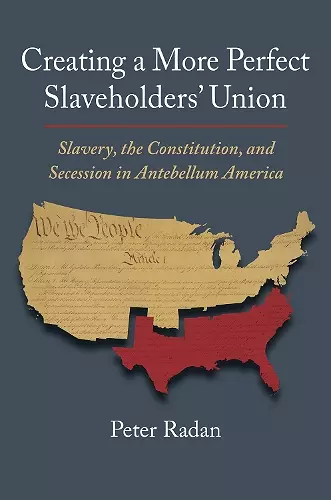Creating a More Perfect Slaveholders' Union
Slavery, the Constitution, and Secession in Antebellum America
Format:Hardback
Publisher:University Press of Kansas
Published:31st Oct '23
Should be back in stock very soon

In Texas v. White (1869), the Supreme Court of the United States ruled that the unilateral secession of a state from the Union was unconstitutional because the Constitution created “an indestructible Union, composed of indestructible States.” The Court ruled “there was no place for reconsideration, or revocation, except through revolution, or through consent of the States.” In his iconoclastic work, Peter Radan demonstrates why the Court’s ruling was wrong and why, on the basis of American constitutional law in 1860–1861, the unilateral secessions of the Confederate states were lawful on the grounds that the United States was forged as a “slaveholders’ Union.”
Creating a More Perfect Slaveholders’ Union addresses two constitutional issues: first, whether the states in 1860 had a right to secede from the Union and second, what significance slavery had in defining the constitutional Union. These two matters came together when the states seceded on the grounds that the system of government they had agreed to—namely, a system of human enslavement—had been violated by the incoming Republican administration. The legitimacy of this secession was anchored, as Radan demonstrates, in the compact theory of the Constitution, which held that because the Constitution was a compact between the member states of the Union, breaches of its fundamental provisions gave affected states the right to unilaterally secede from the Union. In so doing the Confederate states sought to preserve and protect their peculiar institution by forming a more perfect slaveholders’ Union.
Creating a More Perfect Slaveholders’ Union stands as the first and only systematic analysis of the legal arguments mounted for and against secession in 1860–1861 and reshapes how we understand the Civil War and, consequently, the history of the United States more generally.
Peter Radan has produced a very learned defense of secession under the constitutions of 1878 and 1860. The author successfully challenges conventional wisdom that Abraham Lincoln was speaking unquestioned constitutional truth when in his inaugural address he pronounced Southern secession unconstitutional. The constitutional right of a state in 1787 and 1860 to secede from the Union, Radan livingly details, was at least as plausible as the conventional claim that states in 1787 and afterward had no constitutional right to secede from the Union." - Mark A. Graber, Regents Professor, University of Maryland Carey School of Law, and author of Punish Treason, Reward Loyalty: The Forgotten Goals of the Constitutional Reform after the Civil War
"In this important, pathbreaking book, Peter Radan takes a close look at an idea that has been off-limits for over a hundred years: that the Confederate arguments for secession might have had some merit. With the Civil War fresh in American minds, secessionist arguments had to be branded as heresy, and they were. But now that we have more distance, we can afford to take a new and more objective look. And what we learn about injustices of the past may show the way to a more just future." - Kermit Roosevelt, David Berger Professor for the Administration of Justice at the University of Pennsylvania Carey Law School, and author of The Nation That Never Was: Reconstructing America’s Story
ISBN: 9780700635801
Dimensions: unknown
Weight: 272g
448 pages